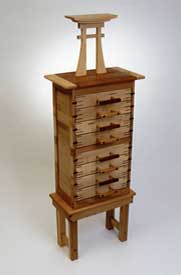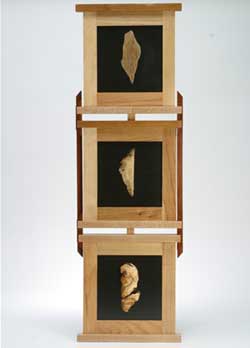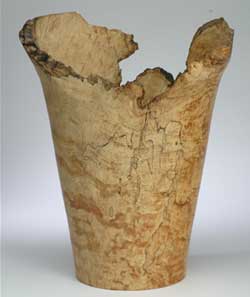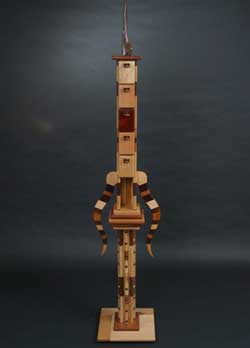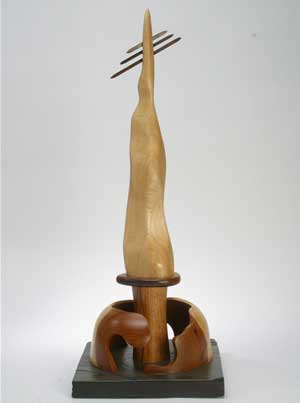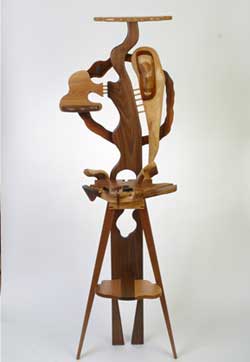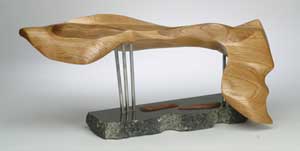
Joel Cole’s woodworking is strongly tied to place: where he is now, where he’s been, and where he hopes to go.
Joel, who was a high school exchange student in the Faroe Islands, an archipelago located between Iceland and Scotland, in the 1980s, says that the visual influence of this Scandinavian country is one reason he likes to use contrasting woods in his work. He describes the country as a “visual feast,” with villages of houses painted bright yellow, pink and purple on rugged basalt islands – where he also finds, in this “country of contrasts, blues of the sky and greens of the grass and grays of the ocean.”
He’s been back to the Faroes at least once a year ever since his exchange student days, and hopes to someday soon move his woodworking practice there – after figuring out the logistics of moving a woodworking studio, fumigating his wood for an international move, etc.
Meanwhile, Joel is living and working in the Minneapolis area, where he tries to make a point of using material that he can follow from its source to the final product. When he started work as a woodworker, this approach “came out of poverty,” Joel said. “I didn’t have enough money to invest in the kind of materials I wanted to use.” Now, however, “it really is a premise of my work.”
Most often, he will identify a dead or dying tree, contact the landowner about permission to use the lumber, and take the tree out of its spot by means designed not to hurt the environment. Joel has a friend with a mill who mills the wood for him, and he will also incorporate other materials besides wood into his work – such as bones or antlers that have been shed or found from a dead animal, or stones he has gathered. Many of these items he’s found in a variety of countries, during trips taken as a freelance travel journalist.
His favorite wood to find, however, is sugar maple, partly because it is strong wood with fun grain patterns, Joel said, and partly because, “I like the idea that I can get a lot of it close to where I am – shopping locally.” Since he works with so many contrasts, however, Joel notes that he does still have to be aware of “darker stuff” to go with the light colors of maple.
For instance, he notes that he’ll frequently use contrasting woods to make joinery a highlight of a furniture piece – “I like to explore as much joinery as possible, and show how things are put together,” he said.
Overall, Joel sees himself a wood sculptor, who has learned various techniques, such as woodturning, in order to achieve what he wants to be able to do in sculptural work. It seemed a natural progression to him from earlier careers in theater and music. Noting that, as the youngest of three children, he made a niche for himself as “the performer of the family,” Joel said, “I’ve always had the desire, or the need, to express myself creatively.”
Around the turn of the millennium, Joel was doing stage work with children when he entered woodworking in a local art fair, and sold everything he’d brought to the show. He had learned woodworking as a child from his father, an educator and school administrator who would unwind at the end of the day by building projects for family and friends in his garage woodshop. “I was always welcome to join him,” Joel said, “and, since he was an educator, he was good at teaching me.”
At that time, Joel said, “there was a lot of public energy in my life, and I needed to do something more isolated” – which led to his switch to becoming a full-time woodworker. Still, he notes, a lot of people contend that they find lyrical and melodic qualities in his wood sculpture work.
Since much of that work focuses on unstable pieces of wood – which might be rotting, have holes in them, or checks in his turnings – there are sometimes technical failures during the building process, Joel said. That’s one reason that his piece “Slay the Beast” is a favorite: not only is it one of the “flagship pieces” he tries to build every third year or so, but it was purchased the day after he completed it – and “all the things I planned to do as I executed it were successful.”
